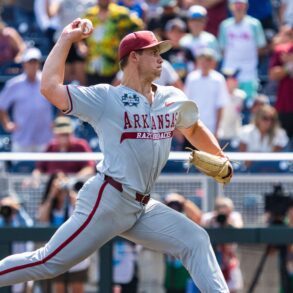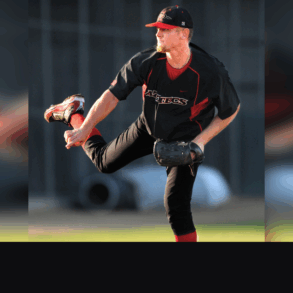
With fall baseball soon coming to an end, freshmen across the country have been able to showcase their talent for their respective programs. In what is the case each season, a number of freshmen will make a sizable impact in their first year on campus. While some have begun to carve out a meaningful role, others will play their way into one as the season progresses. It still isn’t exactly crystal clear who is going to start on day one, but below you will find 10 freshmen who are poised to make an impact in 2025.
Schmidt had legitimate first-round interest in last July’s draft, but he sent shockwaves through the baseball world when he announced on night one of the draft that he would be attending LSU. The No. 22 ranked prospect on the final BA 500, Schmidt has an impressive arsenal that includes a mid-90s fastball that has been up to 98, a low-to-mid-80s changeup that right now is a work-in-progress and—the headliner—a devastating low-80s curveball. Many had the pitch tabbed as the best of its kind in last year’s draft, and it is a high-spin offering with spin rates routinely in the 2,900+ range, big-time depth and a sharp 12-to-6 shape. It gets whiffs both in and out of the zone, and Schmidt has shown he can also land the pitch for strikes.
LSU’s rotation is deep, but Schmidt this spring is poised to log his fair share of innings.
It’s hard to think of a freshman hitter who has had a louder fall than Carns. The 6-foot backstop had top-three round draft interest, but instead opted to honor his commitment to Florida State. This fall, Carns has been one of the Seminoles’ best hitters and is on track to be in the opening day lineup. He’s a high-level athlete who has plenty of hand speed at the plate and has routinely flashed his all-fields power.
Carns’ athleticism also translates well behind the dish, where he moves well laterally and boasts a strong arm. The Seminoles also have Jaxson West at catcher. Carns’ toolset profiles well in the outfield where his athleticism, speed and arm all translate.
Jay Abernathy, SS, Tennessee
Getting Abernathy to campus was a big win for head coach Tony Vitello and his staff. Abernathy is a quick-twitch athlete who’s a 70-grade runner and boasts advanced bat-to-ball skills. Right now he is more of a “slash-and-dash” hitter, but he could grow into more impact if he’s able to add strength and physicality to his frame. He puts pressure on opposing defenses and projects as a leadoff table setter.
Abernathy collected a pair of hits in each of Tennessee’s scrimmages and has seen time both on the dirt and in the outfield. With the Volunteers’ infield consisting of Andrew Fischer, Dean Curley and Gavin Kilen, Abernathy’s best path to consistent playing time will likely come in left field. However, he should seamlessly slide to the infield in 2026.
Dax Whitney, RHP, Oregon State
Whitney was one of the most popular helium arms in the 2024 draft cycle and had pitched his way into being a potential day-one option. He’s enjoyed a productive fall and is in a great spot to log meaningful innings this spring.
At 6-foot-5 and 195-pounds, Whitney has a great body with projection remaining. His fastball this fall has been up to 98 with life through the zone, a pitch he supplements with a curveball, slider and changeup. Whitney’s curveball is the best of his three secondary offerings, and it flashes serious depth with sharp, downward teeth. His slider is shorter in shape and his changeup is a fine fourth pitch. Whitney has the look of a future rotation headliner, and it might be sooner rather than later.
Tyler Bell, SS, Kentucky
Bell was drafted by the Rays in the second-round of this year’s draft, but surprised many when he decided not to sign. Unsurprisingly, Bell has shown well this fall and is on track to be the Wildcats’ opening day shortstop. Bell is a fluid defender with silky smooth actions, an above-average arm and strong internal clock. He looks like a strong bet to stick at the position long term, and will provide a considerable boost to Kentucky’s defense this season.
At the plate, Bell is a switch-hitter whose swing can get a little long at times, but he makes consistent contact and has flashed solid power from both sides, especially to the pull side as a lefthanded hitter. Bell has the tools on both sides of the baseball to be one of the more productive freshmen in the SEC this spring. Bell will be eligible for the draft again in 2026, where he again has day one upside.
Duncan Marsten, RHP, Wake Forest
After missing all of 2022 recovering from Tommy John surgery, Marsten flashed big stuff last spring that attracted top-four round draft interest. He has an effortless delivery and his fastball has been up to 99. It sits in the low-to-mid-90s. In addition to his heater, Marsten boasts a pair of above-average secondary pitches in a low-80s slider and a mid-80s changeup. His changeup might be the better of the two, and this fall it has looked like a valuable weapon.
Marsten has shown well early on, and in a recent scrimmage against West Virginia he struck out a pair and allowed just one hit across three shutout innings. The Demon Deacons need to replace its entire 2024 rotation, and while transfers Matthew Dallas and Logan Lunceford will account for two of the weekend rotation slots, Marsten could compete for the third.
Talan Bell, LHP, Clemson
Bell has opened plenty of eyes this fall and is destined for a sizable role on the bump this spring. A two-way player in high school, Bell is highly advanced on the mound. His fastball would sit in the high-80s-to-low-90s as a prep, but it has been into the mid-90s this fall with running life through the zone.
Bell also has an above-average mid-80s changeup in his arsenal, as well two distinct breaking balls in a low-80s slider and a mid-70s curveball that take on a bigger shape. As a cherry on top to his deep pitch-mix, Bell is an advanced strike-thrower whose ability to locate helps his arsenal play up. Clemson has shown it isn’t afraid to give a freshman a major role if he’s earned it—see Aidan Knaak—and Bell could be next in line.
Owen Paino, SS, Mississippi
Paino had long been one of the more recognizable names in the 2024 class and had plenty of draft chatter in the lead up to the draft. He withdrew his name on July 14—day one of the draft—and while it was not as big a surprise as someone like William Schmidt, it was still a major win for Ole Miss.
Paino has hit the ground running this fall, showing well in both intrasquad scrimmages and games against other programs. The 6-foot-3 infielder has solid control of the strike zone and a sound approach, and this fall he has gotten to his above-average power on a consistent basis. Paino has blasted a handful of home runs, and has also been one of the Rebels’ top performers in their scrimmages against North Alabama and Samford.
The biggest key for Paino in order to achieve his offensive upside will be how his hit tool progresses, but the start to his college career has been encouraging. With Luke Hill back at shortstop, Paino this spring could see time at both second and third base. Long term, his defensive skillset might translate best at the hot corner.
Brodie Johnston, INF, Vanderbilt
Johnston didn’t have the same type draft buzz as the other names mentioned, but he is the only one who played on the college circuit this past summer. In the Appy League, Johnston hit .284/.351/.479 with six doubles, six triples, five home runs and 47 RBIs across 43 games. He was not only named an all-star, but took home MVP honors in the all-star game. Johnston carried over his hot hitting into the fall, where he launched three home runs across three fall World Series games. He’s a physical player who looks to do damage each time in the box, and he has an intriguing hit-power blend. Johnston has a quiet setup in the box with a wide base, and there is an appealing compact explosiveness to his operation. He also runs well and figures to make an impact on the basepaths. Where Johnston fits defensively is a bit of a question mark, but his bat projects to be enough to have him be a consistent member of the starting nine in 2025.
Mason Russell, LHP, Arizona
Russell stood out as one of the best pitching prospects in the Four Corners region of the country this past draft cycle. The 6-foot-1, 185-pound lefthander has a smooth, clean delivery, strength throughout his frame—especially in his lower-half—and an advanced feel to spin the baseball. Russell moves well on the mound and features a low-90s fastball that this fall has been up to 94, a pair of potentially above-average breaking balls in a low-80s slider and a mid-to-upper 70s curveball and a mid-80s changeup. Russell’s curveball is arguably the better of the two, and it routinely flashes big-time depth with sharp, downward tilt. The biggest key for Russell during his time at Arizona will be adding polish in the pitchability department. However, early reports this fall have been encouraging and he looks the part of a future weekend starter and eventual top-five round draft choice.
This post was originally published on this site be sure to check out more of their content.





